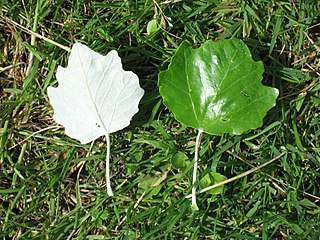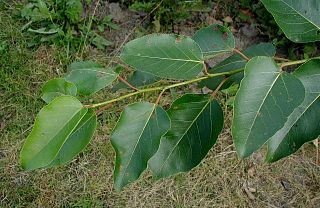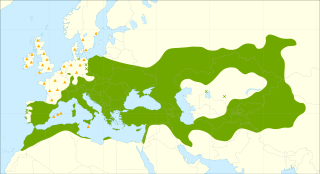White poplar is a common name used to refer to several trees in the genus Populus , including:
- Populus alba , native to Eurasia
- Populus grandidentata , bigtooth aspen
- Populus tremuloides , American aspen
- Populus tomentosa , Chinese white poplar
White poplar is a common name used to refer to several trees in the genus Populus , including:

Populus is a genus of 25–30 species of deciduous flowering plants in the family Salicaceae, native to most of the Northern Hemisphere. English names variously applied to different species include poplar, aspen, and cottonwood.

Populus section Populus, of the Populus (poplar) genus, includes the aspen trees and the white poplar Populus alba. The five typical aspens are all native to cold regions with cool summers, in the north of the Northern Hemisphere, extending south at high altitudes in the mountains. The White Poplar, by contrast, is native to warmer regions, with hot, dry summers. These trees are all medium-sized deciduous trees ranging 15–30 metres (49–98 ft) tall.

The balsam poplars are a group of about 10 species of poplars, indigenous to North America and eastern Asia, distinguished by the balsam scent of their buds, the whitish undersides of their leaves, and the leaf petiole being round in cross-section. They are large deciduous trees, 30–60 m tall, with leaves with a rounded base, pointed apex, and a whitish waxy coating on the underside of the leaf; this latter distinguishes them from most other poplars. The name is derived from the pleasant balsam smell of the opening buds and leaves in spring, produced by a sticky gum on the buds which also helps protect the buds from insect damage. The balsam poplars are light-demanding trees that require considerable moisture. Poplars are tolerant of very cold conditions, occurring further north than other poplars except for the aspens. The poplars in Southern California are tolerant of 100 plus degree heat. They grow along dry washes and dry riverbed‘s. The dry washes and dry riverbeds will have flowing water when it rains sufficiently. Their leaves hang down and are at an edge to the sun. This may be another factor why they can take the high heat. Their leaves tremble in the slightest breeze like the quaking aspensource needed

Populus alba, commonly called silver poplar, silverleaf poplar, or white poplar, is a species of poplar, most closely related to the aspens. It is native to Morocco and then Spain through central Europe to central Asia. It grows in moist sites, often by watersides, in regions with hot summers and cold to mild winters.
Leuce may refer to:
Poplar may refer to:

Populus tremuloides is a deciduous tree native to cooler areas of North America, one of several species referred to by the common name aspen. It is commonly called quaking aspen, trembling aspen, American aspen, mountain or golden aspen, trembling poplar, white poplar, and popple, as well as others. The trees have tall trunks, up to 25 meters tall, with smooth pale bark, scarred with black. The glossy green leaves, dull beneath, become golden to yellow, rarely red, in autumn. The species often propagates through its roots to form large clonal groves originating from a shared root system. These roots are not rhizomes, as new growth develops from adventitious buds on the parent root system.

Aspen Island, within Lake Burley Griffin, is a man-made island located in Canberra, Australian Capital Territory, Australia.

Populus tremula, commonly called aspen, common aspen, Eurasian aspen, European aspen, or quaking aspen, is a species of poplar native to cool temperate regions of Europe and Asia, from Iceland and the British Isles east to Kamchatka, north to inside the Arctic Circle in Scandinavia and northern Russia, and south to central Spain, Turkey, the Tian Shan, North Korea, and northern Japan. It also occurs at one site in northwest Africa in Algeria. In the south of its range, it occurs at high altitudes in mountains.

Populus grandidentata, commonly called large-tooth aspen, big-tooth aspen, American aspen, Canadian poplar, or white poplar, is a deciduous tree native to eastern North America.

Aspen is a common name for certain tree species; some, but not all, are classified by botanists in the section Populus, of the Populus genus.
Entoleuca mammata is a species of fungus in the genus Entoleuca. It is responsible for the plant disease hypoxylon canker in hardwood trees such as quaking aspen and other aspens and poplars, Salix myrsinifolia and other willow species, rowan, Sitka alder, birch, apple, oak, and hop-hornbeam.

Populus × canescens, the grey poplar, is a hybrid between Populus alba and Populus tremula. It is intermediate between its parents, with a thin grey downy coating on the leaves, which are also much less deeply lobed than the leaves of P. alba. It is a very vigorous tree with marked hybrid vigour, reaching 40 m tall and with a trunk diameter over 1.5 m – much larger than either of its parents. Most trees in cultivation are male, but female trees occur naturally and some of these are also propagated.

Gardabani Managed Reserve is a protected area in Gardabani Municipality and Marneuli Municipality in Kvemo Kartli region of Georgia. Reserve is located on the left bank of Mtkvari river near the Azerbaijan border at a distance of 39 km from Tbilisi. It protects floodplain forest groves as well as local fauna. It has been considered to be included into Ramsar Convention list of Wetlands of international importance. Gardabani Managed Reserve is part of the Georgian protected areas system which also includes Tbilisi National Park, Saguramo Range, Gldani, Martqopi, Gulele.